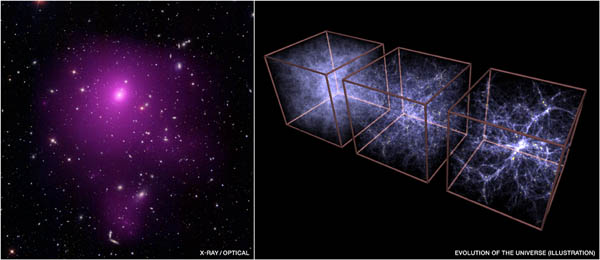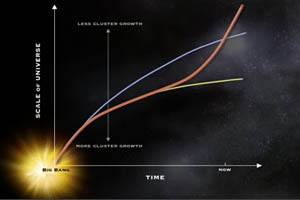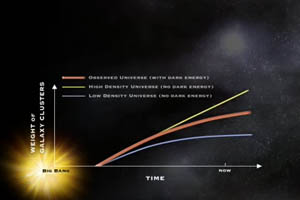Imagine the Universe News - 17 December 2008
Dark Energy Found Stifling Growth in Universe
| 17 December 2008 |
 Click for larger image |
| The composite image on the left is of the galaxy cluster Abell 85, located about 740 million light years from Earth. The illustration on the right shows snapshots from a simulation, representing the growth of cosmic structure when the Universe was 0.9 billion, 3.2 billion and 13.7 billion years old (now). (Credit: X-ray (NASA/CXC/SAO/A.Vikhlinin et al.); Optical (SDSS); Illustration (MPE/V.Springel)) |
For the first time, astronomers have clearly seen the effects of "dark energy" on the most massive collapsed objects in the universe using NASA's Chandra X-ray Observatory. Astronomers have tracked how dark energy has stifled the growth of galaxy clusters and combined this with previous studies. By doing so, scientists have obtained the best clues yet about what dark energy is and what the destiny of the universe could be.
This work, which took years to complete, is separate from other methods of dark energy research such as supernovas. These new X-ray results provide a crucial independent test of dark energy, long sought by scientist. This shows how gravity competes with dark energy, which causes an accelerated expansion in the growth of cosmic structures. Techniques based on distance measurements, such as supernova work, do not have this special sensitivity.
| The galaxy cluster, Abell 85, is shown in optical light, and then in X-ray light as seen from NASA's Chandra X-ray Observatory. (Credits: X-ray (NASA/CXC/SAO/A.Vikhlinin et al.); Optical (SDSS)) (Video Description) |
Scientists think dark energy is a form of repulsive gravity that now dominates the universe, although they have no clear idea of what it actually is. Understanding the nature of dark energy is one of the biggest problems in science. Possibilities include the cosmological constant, which is equivalent to the energy of empty space. Other possibilities include a modification in general relativity on the largest scales, or a more general physical field.
To help decide between these options, scientists are looking at dark nergy in a new way. Scientists are observing how cosmic acceleration affects the growth of galaxy clusters over time.
"This result could be described as 'arrested development of the universe'," said Alexey Vikhlinin of the Smithsonian Astrophysical Observatory in Cambridge, Mass., who led the research. "Whatever is forcing the expansion of the universe to speed up is also forcing its development to slow down."
Vikhlinin and his colleagues used Chandra to observe the hot gas in dozens of galaxy clusters. Some of these clusters are relatively close and others are more than halfway across the universe.
| The simulation shows how the Universe has evolved from soon after the Big Bang to the present day. (Credits: MPE/V.Springel) (Video Description) |
The results show the rate at which mass of the galaxy clusters increases over time is consistent with a universe dominated by dark energy. Vikhlinin and his team see that it is more difficult for objects like galaxy clusters to grow when space is being stretched by dark energy. The results are remarkably consistent with those from the distance measurements. This means that general relativity applies on large scales, as scientists expected.
"For years, scientists have wanted to start testing how gravity works on large scales and now, we finally have," said William Forman, a co-author of the study from the Smithsonian Astrophysical Observatory. "This is a test that general relativity could have failed."
When combined with other clues -- supernovas, the study of the cosmic microwave background, and the distribution of galaxies -- this new X-ray result gives scientists the best insight to date on the properties of dark energy.
The study strengthens the evidence that dark energy is the cosmological constant. Although it is the leading candidate to explain dark energy, theoretical work suggests it should be about 10120 times larger than observed. Therefore, alternatives to general relativity, such as theories involving hidden dimensions, are being explored.
"Putting all of this data together gives us the strongest evidence yet that dark energy is the cosmological constant, or in other words, that 'nothing weighs something'," said Vikhlinin. "A lot more testing is needed, but so far Einstein's theory is looking as good as ever."
These results have consequences for predicting the ultimate fate of the universe. If dark energy is explained by the cosmological constant, the expansion of the universe will continue to accelerate, and the Milky Way and its neighbor galaxy, Andromeda, never will merge with the nearby Virgo cluster. In that case, about a hundred billion years from now, all other galaxies ultimately would disappear from the Milky Way's view and, eventually, the local superclusters of galaxies also would disintegrate.
The work by Vikhlinin and his colleagues will be published in two separate papers in the Feb. 10 issue of The Astrophysical Journal. NASA's Marshall Space Flight Center in Huntsville, Ala., manages the Chandra program for NASA's Science Mission Directorate in Washington. The Smithsonian Astrophysical Observatory controls Chandra's science and flight operations from Cambridge, Mass.



